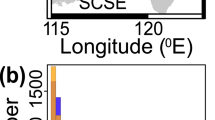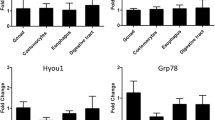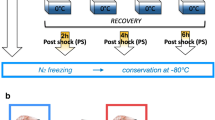Abstract
The classical heat shock response (HSR) with up-regulation of hsp70 in response to warming is often absent in Antarctic marine species. Whilst in Antarctic fish, this is due to a mutation in the gene promoter region resulting in permanent constitutive expression of the inducible form of hsp70; there are further questions as to whether evolution to life below 0 °C has resulted in a generalised alteration to the HSR in Antarctic marine invertebrates. However, the number of species investigated to date is limited. In the first evaluation of the HSR in two spirorbid polychaetes Romanchella perrieri and Protolaeospira stalagmia, we show highly variable results of HSR induction depending on warming regimes. These animals were subjected to in situ warming (+ 1 °C and + 2 °C above ambient conditions) using heated settlement panels for 18 months, and then the HSR was tested in R. perrieri using acute and chronic temperature elevation trials. The classic HSR was not induced in response to acute thermal challenge in this species (2 h at 15 °C) and significant down-regulation of hsp90 occurred during chronic warming at 4 °C for 30 days. Analysis of heat shock protein (HSP) genes in a transcriptome study of P. stalagmia, which had been warmed in situ for 18 months, showed up-regulation of HSP70 and HSP90 family members, thus further emphasising the complexity of the response in Antarctic marine species. It is increasingly apparent that the Antarctic HSR has evolved in a species-specific manner to life in the cold.



Similar content being viewed by others
References
Altschul SF, Gish W, Miller W, Myers EW, Lipman DJ (1990) Basic local alignment search tool. J Mol Biol 215:403–410
Ashton GV, Morley SA, Barnes DKA, Clark MS, Peck LS (2017) Warming by 1 degrees C drives species and assemblage level responses in Antarctica’s marine shallows. Curr Biol 27:2698–2705
Bolger AM, Lohse M, Usadel B (2014) Trimmomatic: a flexible trimmer for Illumina sequence data. Bioinformatics 30:2114–2120
Brocchieri L, Karlin S (2000) Conservation among HSP60 sequences in relation to structure, function, and evolution. Protein Sci 03:476–486
Buckley BA, Place SP, Hofmann GE (2004) Regulation of heat shock genes in isolated hepatocytes from an Antarctic fish, Trematomusbernacchii. J Exp Biol 207:3649–3656
Cascella K, Jollivet D, Papot C, Leger N, Corre E, Ravaux J, Clark MS, Toullec JY (2015) Diversification, evolution and sub-functionalization of 70kda heat-shock proteins in two sister species of Antarctic krill: Differences in thermal habitats, responses and implications under climate change. PLoS One 10:e0121642
Clark MS, Fraser KPP, Peck LS (2008a) Antarctic marine molluscs do have an HSP70 heat shock response. Cell Stress Chaperones 13:39–49
Clark MS, Fraser KPP, Peck LS (2008b) Lack of an HSP70 heat shock response in two Antarctic marine invertebrates. Polar Biol 31:1059–1065
Clark MS, Fraser KPP, Burns G, Peck LS (2008c) The HSP70 heat shock response in the Antarctic fish Harpagiferantarcticus. Polar Biol 31:171–180
Clark MS, Thorne MAS, Toullec JY, Meng Y, Guan LL, Peck LS, Moore S (2011) Antarctic krill 454 pyrosequencing reveals chaperone and stress transcriptome. PLoS One 6:e15919
Clark MS, Nieva LV, Hoffman JI, Davies AJ, Trivedi UH, Turner F, Ashton GV, Peck LS (2019) Lack of long-term acclimation in Antarctic encrusting species suggests vulnerability to warming. Nat Comms 10:3383
Clark MS, Peck LS (2009a) HSP70 heat shock proteins and environmental stress in Antarctic marine organisms: a mini-review. Mar Gen 2:11–18
Clark MS, Peck LS (2009b) Triggers of the HSP70 stress response: environmental responses and laboratory manipulation in an Antarctic marine invertebrate (Nacella concinna). Cell Stress Chaperones 14:649–660
Clark MS, Sommer U, Sihra JK, Thorne MAS, Morley SA, King M, Viant MR, Peck LS (2017) Biodiversity in marine invertebrate responses to acute warming revealed by a comparative multi-omics approach. Glob Change Biol 23:318–330
Collins M, Peck LS, Clark MS (2021) Large within, and between, species differences in marine cellular responses: unpredictability in a changing environment. Sci Total Environ 794:148594
Cottin D, Ravaux J, Leger N, Halary S, Toullec JY, Sarradin PM, Gaill F, Shillito B (2008) Thermal biology of the deep-sea vent annelied Paralvinella grasslei: in vivo studies. J Exp Biol 211:2196–2204
Feder ME, Hofmann GE (1999) Heat-shock proteins, molecular chaperones, and the stress response: evolutionary and ecological physiology. Ann Rev Physiol 61:243–282
González K, Gaitán-Espitia J, Font A, Cárdenas CA, González-Aravena M (2016) Expression pattern of heat shock proteins during acute thermal stress in the Antarctic sea urchin, Sterechinus neumayeri. Rev Chil Hist Nat 89:2
González-Aravena M, Calfio C, Mercado L, Morales-Lange B, Bethke J, De Lorgeril J, Cárdenas CA (2018) HSP70 from the Antarctic sea urchin Sterechinus neumayeri: Molecular characterization and expression in response to heat stress. Biol Res 51:8
Grabherr MG, Haas BJ, Yassour M, Levin JZ, Thompson DA, Amit I, Adiconis X, Fan L, Raychowdhury R, Zeng QD et al (2011) Full-length transcriptome assembly from RNA-Seq data without a reference genome. Nat Biotechnol 29:644–652
Gupta RS (1995) Phylogenetic analysis of the 90 kd heat-shock family of protein sequences and an examination of the relationship among animals, plants, and fungi species. Mol Biol Evol 12:1063–1073
Hofmann GE, Buckley BA, Airaksinen S, Keen JE, Somero GN (2000) Heat-shock protein expression is absent in the Antarctic fish Trematomus bernacchii (family Nototheniidae). J Exp Biol 203:2331–2339
Kim D, Pertea G, Trapnell C, Pimentel H, Kelley R, Salzberg SL (2013) TopHat2: Accurate alignment of transcriptomes in the presence of insertions, deletions and gene fusions. Genome Biol 14:R36
La Terza A, Papa G, Miceli C, Luporini P (2001) Divergence between two Antarctic species of the ciliate Euplotes, E. focardii and E. nobilii, in the expression of heat-shock protein 70 genes. Mol Ecol 10:1061–1067
Li H, Handsaker B, Wysoker A, Fennell T, Ruan J, Homer N, Marth G, Abecasis G, Durbin R, 1000 genome project data processing sub-group (2009) the sequence alignment/map format and SAM tools. Bioinformatics 25:2078–2079
Marchler-Bauer A, Anderson JB, Derbyshire MK, DeWeese-Scott C, Gonzales NR, Gwadz M, Hao LN, He SQ, Hurwitz DI, Jackson JD et al (2007) CDD: a conserved domain database for interactive domain family analysis. Nucl Acid Res 35:D237–D240
Papot C, Cascella K, Toullec JY, Jollivet D (2016) Divergent ecological histories of two sister Antarctic krill species led to contrasted patterns of genetic diversity in their heat-shock protein (hsp70) arsenal. Ecol Evol 6:1555–1575
Peck LS (2016) A cold limit to adaptation in the sea. Trend Ecol Evol 31:13–26
Pfaffl MW, Horgan GW, Dempfle L (2002) Relative expression software tool (REST (c)) for group-wise comparison and statistical analysis of relative expression results in real-time PCR. Nucl Acid Res 30:e36
Ramsøe A, Clark MS, Sleight VA (2020) Gene network analyses support sub-functionalization hypothesis for duplicated hsp70 genes in the Antarctic clam. Cell Stress Chaperones 25:1111–1116
Song HM, Mu XD, Gu DE, Yang YX, Xu M, Luo JR, Zhang Je HuYC (2014) Molecular characteristics of the HSP70 gene and its differential expression in female and male golden apple snails (Pomaceacanaliculata) under temperature stimulation. Cell Stress Chaperones 19:579–589
Toullec JY, Cascella K, Ruault S, Geffroy A, Lorieux D, Montagné N, Ollivaux C, Lee CY (2020) Antarctic krill (Euphausiasuperba) in a warming ocean: thermotolerance and deciphering Hsp70 responses. Cell Stress Chaperones 25:519–531
Yang JH, Mu YW, Dong SM, Jiang QC, Yang JX (2014) Changes in the expression of four heat shock proteins during the aging process in Brachionuscalyciflorus (rotifera). Cell Stress Chaperones 19:33–52
Acknowledgements
The authors would like to thank Mark Preston for his work on the development of the heated panels, the Rothera marine teams from 2013 to 2016 for help with maintenance of the panels, especially Gail Ashton, Simon Morley and David Barnes.
Funding
The work was funded by NERC standard grant NE/J007501/1 awarded to LSP, which included a tied studentship awarded to LV-N.
Author information
Authors and Affiliations
Corresponding author
Additional information
Publisher's note
Springer Nature remains neutral with regard to jurisdictional claims in published maps and institutional affiliations.
Supplementary Information
Below is the link to the electronic supplementary material.
Rights and permissions
About this article
Cite this article
Nieva, L.V., Peck, L.S. & Clark, M.S. Variable heat shock response in Antarctic biofouling serpulid worms. Cell Stress and Chaperones 26, 945–954 (2021). https://doi.org/10.1007/s12192-021-01235-z
Received:
Revised:
Accepted:
Published:
Issue Date:
DOI: https://doi.org/10.1007/s12192-021-01235-z




